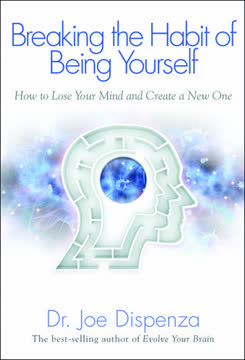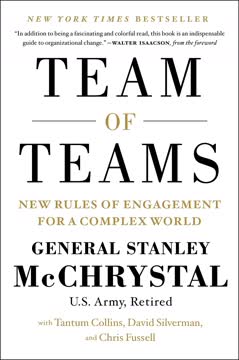Key Takeaways
1. Systems thinking: A holistic approach to problem-solving
"Systems thinking is a discipline for seeing wholes. It is a framework for seeing interrelationships rather than things, for seeing patterns of change rather than static 'snapshots.'"
Expanding perspectives. Systems thinking is a powerful approach to understanding and solving complex problems by looking at the bigger picture. Instead of focusing on isolated events or individual components, it examines the interconnections and relationships within a system. This holistic view allows us to identify underlying patterns, anticipate long-term consequences, and develop more effective solutions.
Key principles:
- Interconnectedness: Everything is connected to everything else
- Synthesis: Understanding the whole system rather than just its parts
- Feedback loops: Recognizing how actions and reactions influence each other
- Emergence: Observing how complex behaviors arise from simple interactions
By adopting systems thinking, we can better navigate the complexities of our world, from personal relationships to global challenges. It encourages us to look beyond immediate symptoms and address root causes, leading to more sustainable and impactful solutions.
2. Elements, interconnections, and purpose: The building blocks of systems
"Systems are more than the sum of their parts; they are the product of their parts' interactions."
Core components. Every system, whether natural or man-made, consists of three fundamental components: elements, interconnections, and purpose (or function). Elements are the tangible or intangible parts of a system, such as people, objects, or ideas. Interconnections are the relationships and information flows that link these elements together. Purpose (or function) is the system's goal or reason for existence.
Understanding systems:
- Elements: Identify the key components within the system
- Interconnections: Map out how these components interact and influence each other
- Purpose: Determine the overall goal or function of the system
By analyzing these three aspects, we can gain a deeper understanding of how systems operate and identify potential areas for improvement or intervention. This framework helps us move beyond superficial observations and develop more comprehensive solutions to complex problems.
3. Feedback loops: The driving force behind system behavior
"A feedback loop is formed when changes in a stock affect the flows into or out of the same stock."
System dynamics. Feedback loops are the mechanisms that drive system behavior over time. There are two main types of feedback loops: reinforcing and balancing. Reinforcing loops amplify changes, leading to exponential growth or decline. Balancing loops counteract changes, maintaining stability or equilibrium within a system.
Key concepts:
- Reinforcing loops: Amplify change (e.g., compound interest, population growth)
- Balancing loops: Counteract change (e.g., thermostat, predator-prey relationships)
- Delays: Time lags between actions and their effects within a system
Understanding feedback loops is crucial for predicting system behavior and identifying effective intervention points. By recognizing these patterns, we can design more targeted and sustainable solutions to complex problems, avoiding unintended consequences and creating positive change.
4. Bottlenecks and leverage points: Identifying key areas for change
"The point of greatest congestion that is causing a delay within a system."
Strategic intervention. Bottlenecks are constraints that limit a system's overall performance, while leverage points are areas where small changes can lead to significant improvements. Identifying these key areas is crucial for effective problem-solving and system optimization.
Strategies for improvement:
- Locate bottlenecks: Find the most significant constraints in the system
- Identify leverage points: Look for areas where small changes can have big impacts
- Apply the 80/20 rule: Focus on the 20% of efforts that yield 80% of results
- Consider tradeoffs: Recognize that improving one area may affect others
By focusing on bottlenecks and leverage points, we can allocate resources more efficiently and create more impactful solutions. This approach helps us avoid wasting time and energy on superficial fixes and instead address the root causes of systemic issues.
5. Shifting from linear to systems thinking: Overcoming mental barriers
"The problems cannot be solved using the same level of thinking that created them."
Paradigm shift. Moving from linear, cause-and-effect thinking to systems thinking requires overcoming several mental barriers. This shift involves recognizing the interconnectedness of problems, embracing complexity, and challenging our assumptions about how the world works.
Overcoming barriers:
- Avoid quick-fix mentality: Look for long-term, sustainable solutions
- Embrace complexity: Recognize that simple solutions may not address root causes
- Challenge assumptions: Question established ways of thinking and problem-solving
- Cultivate patience: Understand that systemic changes take time to manifest
By adopting systems thinking, we can develop more nuanced and effective approaches to problem-solving. This shift in perspective allows us to see beyond immediate symptoms and address underlying causes, leading to more lasting and impactful solutions.
6. Applying systems thinking to social issues: Homelessness as a case study
"Very often we are the reason for perpetuating the system we wish to change—unintentionally, of course."
Complex social challenges. Applying systems thinking to social issues like homelessness reveals the intricate web of factors contributing to the problem. By examining the interconnections between various stakeholders, policies, and societal structures, we can develop more comprehensive and effective solutions.
Key considerations:
- Identify stakeholders: Understand the perspectives of all parties involved
- Map system dynamics: Examine how different factors influence each other
- Recognize unintended consequences: Anticipate potential negative outcomes
- Align incentives: Create solutions that benefit all stakeholders
Systems thinking helps us move beyond short-term fixes and address the root causes of social issues. By considering the whole system, we can develop more sustainable and equitable solutions that address the needs of all stakeholders involved.
7. Systems thinking in practice: The Less-to-Landfill initiative
"Without taking a systems thinking approach, this initiative would have never worked."
Real-world application. The Less-to-Landfill initiative at Sabre Holdings demonstrates the power of systems thinking in solving complex organizational challenges. By mapping out waste management systems, identifying feedback loops, and continuously adapting their approach, the company achieved remarkable improvements in waste diversion.
Key lessons:
- Map the system: Identify subsystems and their interconnections
- Use feedback loops: Continuously monitor and adjust based on results
- Engage stakeholders: Involve all levels of the organization in the change process
- Embrace iteration: Be prepared to adapt and refine solutions over time
This case study illustrates how systems thinking can lead to significant improvements in organizational performance and sustainability. By taking a holistic approach and leveraging feedback loops, companies can achieve ambitious goals and create lasting positive change.
8. Personal application: Improving work and life through systems thinking
"You have an influence on someone. They also have influences on others. And this begins a chain reaction."
Individual impact. Systems thinking isn't just for organizations or global issues; it can be applied to personal and professional development as well. By recognizing the interconnections in our lives and work, we can make more informed decisions and create positive change.
Practical applications:
- Analyze personal relationships: Understand how you influence and are influenced by others
- Improve work processes: Identify bottlenecks and leverage points in your workflow
- Set realistic goals: Consider long-term impacts and potential unintended consequences
- Cultivate awareness: Pay attention to patterns and feedback loops in daily life
Applying systems thinking to our personal lives can lead to more balanced, fulfilling, and impactful experiences. By recognizing our place within larger systems, we can make more intentional choices and contribute to positive change in our communities and beyond.
Last updated:
FAQ
1. What is "Think In Systems" by Zoe McKey about?
- Introduction to Systems Thinking: The book introduces the concept of systems thinking, explaining how it differs from linear, cause-effect thinking and why it’s essential for understanding complex problems.
- Practical Application: It provides both theoretical foundations and practical tools for applying systems thinking to personal, professional, and societal challenges.
- Step-by-Step Guidance: Readers are guided through the basics of systems, feedback loops, bottlenecks, leverage points, and real-world examples to help them adopt a systems mindset.
- Accessible Language: Zoe McKey aims to make the discipline approachable, avoiding jargon and using relatable stories and exercises.
2. Why should I read "Think In Systems" by Zoe McKey?
- Solve Complex Problems: The book equips readers with tools to analyze and address complex, recurring issues in life, work, and society that linear thinking can’t solve.
- Improve Decision-Making: By understanding systems, readers can make more informed, strategic decisions and avoid short-term fixes that create long-term problems.
- Personal and Professional Growth: Systems thinking can be applied to self-improvement, relationships, business, and social change, making it widely relevant.
- Beginner-Friendly Approach: It’s designed for those new to systems thinking, offering clear explanations, practical exercises, and real-life examples.
3. What are the key takeaways from "Think In Systems" by Zoe McKey?
- Everything is Interconnected: Systems thinking reveals how elements, interconnections, and purposes shape outcomes in any system.
- Focus on Patterns and Relationships: Instead of just events, look for underlying patterns, feedback loops, and structures that drive behavior.
- Identify Bottlenecks and Leverage Points: Lasting change comes from addressing root constraints and using leverage for maximum impact.
- Shift from Symptom to Cause: Effective problem-solving requires digging deeper than surface symptoms to find and address core issues.
4. How does Zoe McKey define systems thinking in "Think In Systems"?
- Art and Science of Understanding: Systems thinking is described as the art and science of making reliable inferences about behavior by understanding underlying structures.
- Beyond Linear Thinking: It moves beyond simple cause-effect logic to consider circular causality, feedback loops, and dynamic relationships.
- Holistic Perspective: The approach emphasizes synthesis—seeing the whole system and how its parts interact, rather than just analyzing components in isolation.
- Practical Problem-Solving: Systems thinking is positioned as a practical toolkit for mapping, diagnosing, and improving real-world systems.
5. What are the main elements and concepts of systems thinking according to "Think In Systems"?
- Elements, Interconnections, Purpose: Every system consists of elements (actors), interconnections (relationships), and a function or purpose.
- Stocks and Flows: Systems have stocks (quantities that can be measured) and flows (rates of change), which interact over time.
- Feedback Loops: Reinforcing (amplifying) and balancing (stabilizing) feedback loops are central to system behavior.
- Delays and Emergence: Delays in perception, response, and delivery can cause oscillations, while emergence describes how complex outcomes arise from simple interactions.
6. How does "Think In Systems" by Zoe McKey explain feedback loops and their importance?
- Reinforcing Loops: These amplify changes, leading to growth or decline (e.g., compounding interest, population growth).
- Balancing Loops: These stabilize systems, seeking equilibrium (e.g., thermostat regulation, predator-prey balance).
- Shifting Dominance: System behavior often results from the interplay and shifting dominance between reinforcing and balancing loops.
- Practical Examples: The book uses relatable examples like bank accounts, relationships, and business cycles to illustrate feedback loops in action.
7. What is the Iceberg Model in "Think In Systems" and how can it be used?
- Four Levels of Analysis: The model distinguishes between events (visible), patterns (trends), structures (causes), and mental models (beliefs/values).
- Digging Deeper: It encourages looking below the surface of problems to identify recurring patterns, underlying structures, and root mental models.
- Practical Exercise: Readers are guided to apply the model to personal or societal issues, helping them move from symptom management to systemic solutions.
- Broader Perspective: The Iceberg Model helps avoid quick fixes by revealing the deeper causes of persistent problems.
8. How does "Think In Systems" by Zoe McKey suggest identifying and addressing bottlenecks and leverage points?
- Theory of Constraints: Every system has a bottleneck—the tightest constraint limiting performance; improvement requires focusing on this point.
- Leverage for Maximum Impact: Leverage points are places in a system where small changes can produce significant results (e.g., changing rules, improving information flow).
- Pareto Principle: The 80/20 rule is highlighted—most results come from a small portion of effort, so focus on high-leverage actions.
- Iterative Process: The book recommends a cycle of identifying bottlenecks, applying leverage, measuring feedback, and repeating for continuous improvement.
9. What are common obstacles to adopting systems thinking, according to Zoe McKey?
- Linear Thinking Habits: People default to quick fixes, symptom treatment, and shallow analysis, missing deeper systemic causes.
- Fear of Mistakes: Organizations and individuals often avoid change due to fear of visible errors, especially omission errors (failing to act).
- Lack of Awareness and Resources: Systems thinking is a relatively new discipline, often seen as complex or inaccessible due to jargon.
- Resistance to Change: Societal, organizational, and personal inertia make it hard to shift from established ways of thinking and acting.
10. How does "Think In Systems" by Zoe McKey recommend applying systems thinking to everyday and complex problems?
- Visual Mapping: Start by mapping the system visually—identify elements, interconnections, and feedback loops.
- Behavior-Over-Time Graphs: Use graphs to track how problems and solutions evolve, revealing patterns and delays.
- Focus on Ecosystems: Analyze the broader context and relationships, not just isolated events or actors.
- Iterative Problem-Solving: Develop clear statements of the core problem, identify structures and mental models, and design interventions targeting root causes.
11. What are some real-world examples and case studies used in "Think In Systems" by Zoe McKey?
- Personal Life: Examples include managing finances, improving relationships, and self-development using systems thinking tools.
- Business and Organizations: The Sabre Holdings waste diversion initiative demonstrates mapping feedback loops and leveraging culture for sustainability.
- Social Issues: The book analyzes homelessness, drug policy, and education, showing how conflicting subsystem goals can undermine system-wide change.
- Environmental Problems: Case studies like pesticide use and snowplow management illustrate unintended consequences and the need for systemic solutions.
12. What are the best quotes from "Think In Systems" by Zoe McKey and what do they mean?
- "Everything is interconnected." – Emphasizes the core systems thinking principle that no element exists in isolation; all parts influence each other.
- "To solve problems long term, you need to focus on patterns, not just events." – Encourages looking beyond immediate issues to recurring trends and structures.
- "The real goal of systems thinking as a discipline is to help you understand and address system problems." – Highlights the practical, solution-oriented nature of the approach.
- "You can borrow the well-designed systems of the world and use them in your life." – Suggests that proven models (like supply and demand) can be adapted for personal improvement.
- "Systems thinking will change the way you analyze your life." – Underlines the transformative potential of adopting a systems perspective for personal and professional growth.
Review Summary
Think in Systems receives mixed reviews, with ratings ranging from 1 to 5 stars. Some readers find it a good introduction to systems thinking, praising its accessibility and practical examples. Others criticize it as too basic, poorly edited, and lacking depth. Positive reviews highlight its value for beginners and its ability to provide a broad overview of the topic. Negative reviews point out factual errors, simplistic writing, and a lack of substantial content. Overall, the book seems best suited for those new to systems thinking but may disappoint more experienced readers.
Similar Books










Download PDF
Download EPUB
.epub digital book format is ideal for reading ebooks on phones, tablets, and e-readers.




